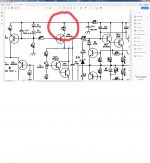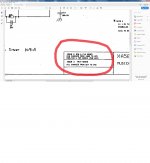I suspect TR6, can you get one to replace
I will have to search my "stock" lol. Lots of old circuit boards.
If I dont find one I can always use the one from the other amp!?!
maybe try this, you take out TR15 and TR16(it is save to do that) and then replace TR16 to TR6, TR15 to TR8
maybe try this, you take out TR15 and TR16(it is save to do that) and then replace TR16 to TR6, TR15 to TR8
I actually have spare ZTX653 and ZTX753 brand new as I had to replace the driver transistors (if thats what they are)
Should I still remove them or just replace the MPSA93 with ZTX753 and MPSA43 with ZTX653?
I actually have spare ZTX653 and ZTX753 brand new as I had to replace the driver transistors (if thats what they are)
Should I still remove them or just replace the MPSA93 with ZTX753 and MPSA43 with ZTX653?
You can use spare ZTX653 and ZTX753 and no need remove transistors on PCB.
Yes, MPSA93 with ZTX753 and MPSA43 with ZTX653
You can use spare ZTX653 and ZTX753 and no need remove transistors on PCB.
Yes, MPSA93 with ZTX753 and MPSA43 with ZTX653
Thanks. Will get back to you in an hour (ish)
Success!!!!
It drops to 5MV! but does start to climb slowly. Was too sacred to leave it running 🙂
Is it safe to leave it running longer? I have no idea what the bias is or what its adjusted to
It drops to 5MV! but does start to climb slowly. Was too sacred to leave it running 🙂
Is it safe to leave it running longer? I have no idea what the bias is or what its adjusted to
You have allready measured V8 1.2mV, it should about that or few mV more.
When you change VAS transistors bias is influenced so better measure V8.
Take it under control 20 min. until temperature stabilise.
Am I see that good that c5 is also changed? If so, we are not sure which one makes problem.
When you change VAS transistors bias is influenced so better measure V8.
Take it under control 20 min. until temperature stabilise.
Am I see that good that c5 is also changed? If so, we are not sure which one makes problem.
You have allready measured V8 1.2mV, it should about that or few mV more.
When you change VAS transistors bias is influenced so better measure V8.
Take it under control 20 min. until temperature stabilise.
Am I see that good that c5 is also changed? If so, we are not sure which one makes problem.
HI,
I will change C5 back but I dont believe that was the problem!
I will measure V8 and post result in a bit.
OK I put the bipolar C5 back and it seemed to lower the DC even more.
I tested it for slightly longer and the DC went from 3MV to around 7MV and rising.
The V8 resistor was also climbing from 0 to around 5MV.
I then shut it down to check for heat, smoke etc and TR6 and TR8 was very hot!!
I tested it for slightly longer and the DC went from 3MV to around 7MV and rising.
The V8 resistor was also climbing from 0 to around 5MV.
I then shut it down to check for heat, smoke etc and TR6 and TR8 was very hot!!
TR6 and TR8 was very hot!!
The resistor R10(47 ohm) control TR6 and TR8 running current(21mA) and it is quite high for the transistors needed.
TR6 and TR8 running half current 10mA is sufficient for them to perform same sounding of the original amp, the temperature will be lower, safe and more stable.
To do that, replace R10 by a 68 ohm resistor.
The resistor R10(47 ohm) control TR6 and TR8 running current(21mA) and it is quite high for the transistors needed.
TR6 and TR8 running half current 10mA is sufficient for them to perform same sounding of the original amp, the temperature will be lower, safe and more stable.
To do that, replace R10 by a 68 ohm resistor.
Hi Patrick,
I may have one of those! Get back to you in a bit 🙂
R10 is stated as 4R7 which is 4.7 ohms, but it measured 47 ohms! How did you know that!?!?
OK so I replaced it and it still gets hot much not as much as before and not as quick. Tested the DC... it went from 5MV to around 15MV and stayed around there.
I also measured the bias R24, this was around 2MV
I also noticed if I keep my finger on TR8 the DC would drop to 2-3MV.
OK so I replaced it and it still gets hot much not as much as before and not as quick. Tested the DC... it went from 5MV to around 15MV and stayed around there.
I also measured the bias R24, this was around 2MV
I also noticed if I keep my finger on TR8 the DC would drop to 2-3MV.
R10 is stated as 4R7 which is 4.7 ohms, but it measured 47 ohms! How did you know that!?!?
OK so I replaced it and it still gets hot much not as much as before and not as quick. Tested the DC... it went from 5MV to around 15MV and stayed around there.
I also measured the bias R24, this was around 2MV
I also noticed if I keep my finger on TR8 the DC would drop to 2-3MV.
The schematic showed R10 47R (you can check in #54)
With 10mA current is also a little high for these transistors(in normal amp design, they are only run at 3mA to 5mA), so that they are still hot, but you would not want to shift too much from factory design, so that let it run in 10mA.
When these transistors heating up, the circuit voltages will shift until the transistors temperature stable, after that you set the bias and it is ok for your amp.
Last edited:
If you like, you can buy this kind of small clip to make a heatsink for these transistors. 🙂
Hahaha those transistors are so small even getting a clip on there will be hard!
I haven't adjusted the bias but can you recommend a good MA for R24 please. Its 2MA currently.
And thanks for all your hard work!!
Hahaha those transistors are so small even getting a clip on there will be hard!
I haven't adjusted the bias but can you recommend a good MA for R24 please. Its 2MA currently.
And thanks for all your hard work!!
20mA for each power transistors is ok, so 4.4mv on R24
Last edited:
- Home
- Amplifiers
- Solid State
- Musical Fidelity X-A50 monoblock amp Circuit



